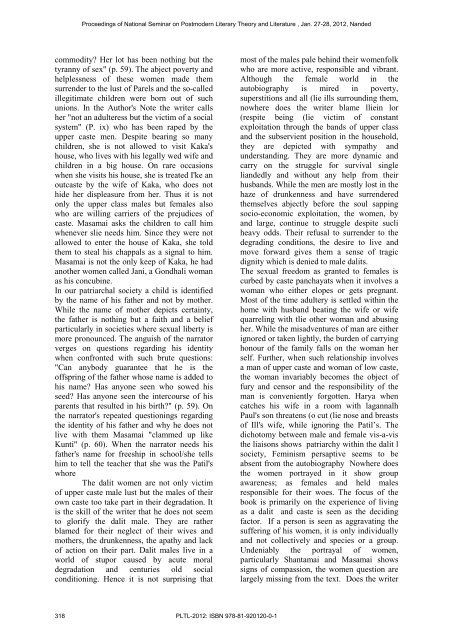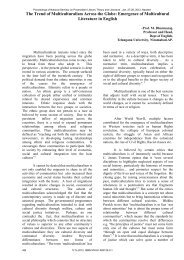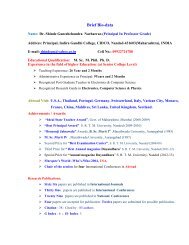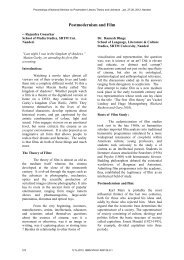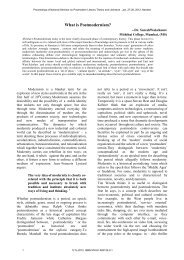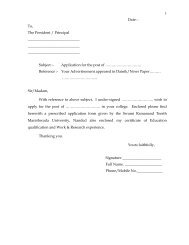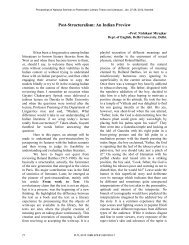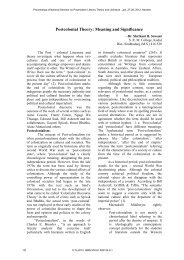Postcolonial Feminist Theory: An Overview - Igcollege.org
Postcolonial Feminist Theory: An Overview - Igcollege.org
Postcolonial Feminist Theory: An Overview - Igcollege.org
You also want an ePaper? Increase the reach of your titles
YUMPU automatically turns print PDFs into web optimized ePapers that Google loves.
Proceedings of National Seminar on Postmodern Literary <strong>Theory</strong> and Literature , Jan. 27-28, 2012, Nandedcommodity? Her lot has been nothing but thetyranny of sex" (p. 59). The abject poverty andhelplessness of these women made themsurrender to the lust of Parels and the so-calledillegitimate children were born out of suchunions. In the Author's Note the writer callsher "not an adulteress but the victim of a socialsystem" (P. ix) who has been raped by theupper caste men. Despite bearing so manychildren, she is not allowed to visit Kaka'shouse, who lives with his legally wed wife andchildren in a big house. On rare occasionswhen she visits his house, she is treated I'ke anoutcaste by the wife of Kaka, who does nothide her displeasure from her. Thus it is notonly the upper class males but females alsowho are willing carriers of the prejudices ofcaste. Masamai asks the children to call himwhenever slie needs him. Since they were notallowed to enter the house of Kaka, she toldthem to steal his chappals as a signal to him.Masamai is not the only keep of Kaka, he hadanother women called Jani, a Gondhali womanas his concubine.In our patriarchal society a child is identifiedby the name of his father and not by mother.While the name of mother depicts certainty,the father is nothing but a faith and a beliefparticularly in societies where sexual liberty ismore pronounced. The anguish of the narratorverges on questions regarding his identitywhen confronted with such brute questions:"Can anybody guarantee that he is theoffspring of the father whose name is added tohis name? Has anyone seen who sowed hisseed? Has anyone seen the intercourse of hisparents that resulted in his birth?" (p. 59). Onthe narrator's repeated questionings regardingthe identity of his father and why he does notlive with them Masamai "clammed up likeKunti" (p. 60). When the narrator needs hisfather's name for freeship in school/she tellshim to tell the teacher that she was the Patil'swhoreThe dalit women are not only victimof upper caste male lust but the males of theirown caste too take part in their degradation. Itis the skill of the writer that he does not seemto glorify the dalit male. They are ratherblamed for their neglect of their wives andmothers, the drunkenness, the apathy and lackof action on their part. Dalit males live in aworld of stupor caused by acute moraldegradation and centuries old socialconditioning. Hence it is not surprising thatmost of the males pale behind their womenfolkwho are more active, responsible and vibrant.Although the female world in theautobiography is mired in poverty,superstitions and all (lie ills surrounding them,nowhere does the writer blame lliein lor(respite being (lie victim of constantexploitation through the bands of upper classand the subservient position in the household,they are depicted with sympathy andunderstanding. They are more dynamic andcarry on the struggle for survival singleliandedly and without any help from theirhusbands. While the men are mostly lost in thehaze of drunkenness and have surrenderedthemselves abjectly before the soul sappingsocio-economic exploitation, the women, byand large, continue to struggle despite sucliheavy odds. Their refusal to surrender to thedegrading conditions, the desire to live andmove forward gives them a sense of tragicdignity which is denied to male dalits.The sexual freedom as granted to females iscurbed by caste panchayats when it involves awoman who either elopes or gets pregnant.Most of the time adultery is settled within thehome with husband beating the wife or wifequarreling with tlie other woman and abusingher. While the misadventures of man are eitherignored or taken lightly, the burden of carryinghonour of the family falls on the woman herself. Further, when such relationship involvesa man of upper caste and woman of low caste,the woman invariably becomes the object offury and censor and the responsibility of theman is conveniently f<strong>org</strong>otten. Harya whencatches his wife in a room with lagannalhPaul's son threatens (o cut (lie nose and breastsof Ill's wife, while ignoring the Patil’s. Thedichotomy between male and female vis-a-visthe liaisons shows patriarchy within the dalit lsociety, Feminism persaptive seems to beabsent from the autobiography Nowhere doesthe women portrayed in it show groupawareness; as females and held malesresponsible for their woes. The focus of thebook is primarily on the experience of livingas a dalit and caste is seen as the decidingfactor. If a person is seen as aggravating thesuffering of his women, it is only individuallyand not collectively and species or a group.Undeniably the portrayal of women,particularly Shantamai and Masamai showssigns of compassion, the women question arelargely missing from the text. Does the writer318 PLTL-2012: ISBN 978-81-920120-0-1


